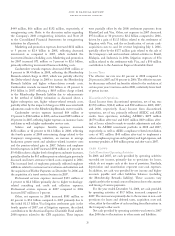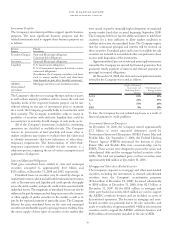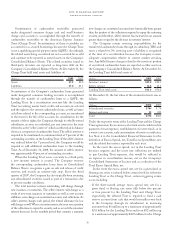American Express 2008 Annual Report Download - page 32
Download and view the complete annual report
Please find page 32 of the 2008 American Express annual report below. You can navigate through the pages in the report by either clicking on the pages listed below, or by using the keyword search tool below to find specific information within the annual report.
2008 financial review
american express company
Investment Portfolios
The Company’s investment portfolios support specific business
purposes. The most significant business purposes and the
related investments used to support those business purposes are
as follows:
Business
Purpose
Primary
Investments
Travelers Cheques State and Municipal obligations
Corporate debt obligations
Insurance State and Municipal obligations
Liquidity U.S. Government obligations
U.S. Government-sponsored-entities senior
unsecured obligations
(In addition, the Company considers cash items
such as money market funds and short-term
time deposits as part of its liquidity resources)
AEIDC –
discontinued
operations
Mortgage and other asset-backed securities
The Company’s objective is to manage the type and mix of assets
as well as their maturity profile in order to ensure the cash and
liquidity needs of the respective business purpose can be met
without relying on the sale of investments prior to maturity.
As a result, the Company generally holds its investments until
their maturity. The Company nonetheless seeks to invest in
portfolios of securities with sufficient liquidity that could be
accessed prior to maturity should changes in cash needs occur.
All of the Company’s investments included in continuing
operations are classified as available-for-sale. The Company
reviews its investments at least quarterly and more often as
market conditions may require to evaluate their fair values and
to identify investments that have indications of other-than-
temporary impairments. The determination of other-than-
temporary impairments for available-for-sale securities is a
subjective process, requiring the use of various assumptions and
application of judgment.
State and Municipal Obligations
Total gross unrealized losses related to state and municipal
securities amounted to approximately $1.0 billion and
$136 million at December 31, 2008 and 2007, respectively.
Unrealized losses on securities may be caused by changes in
market interest rates, which include both benchmark interest rates
such as Treasury rates and liquidity and credit spreads that apply
across the entire market, and specific credit events associated with
individual issuers. The magnitude of unrealized losses may also be
influenced in part by temporary but sharp increases in the issuance
or other supply of similar securities in the market as well as in
part by the expected maturity of particular issues. The Company
believes the gross unrealized losses on the state and municipal
securities are attributable in part to pricing pressures resulting from
the excess supply of these types of securities in the market that
were caused in part by unusually high redemptions of municipal
money market funds that occurred beginning September 2008.
The Company believes it has the ability and intent to hold these
securities for a time sufficient to allow market conditions to
stabilize and recover the unrealized losses. The Company expects
that the contractual principal and interest will be received on
these securities. Unrealized gains and losses on available-for-sale
securities are included in accumulated other comprehensive (loss)
income until disposition of the investments.
Approximately 62 percent of state and municipal investments
owned by the Company are insured by financial guarantors that
guarantee timely payment of interest and ultimate payment of
principal on insured obligations.
At December 31, 2008, the state and municipal investments
owned by the Company were rated as follows:
Higher of Financial
Guarantors’ and
Underlying Issuers’
Ratings
Underlying Issuers’
Ratings without
Regard to Guarantors
AAA 15% 15%
AA 43% 35%
A33% 40%
BBB 9% 10%
To date, the Company has not realized any losses as a result of
financial guarantors’ credit problems.
Government Sponsored Enterprises
At December 31, 2008, the Company owned approximately
$3.2 billion of senior unsecured debentures issued by
Government Sponsored Enterprises (GSEs): Fannie Mae and
Freddie Mac. On September 7, 2008, the Federal Housing
Finance Agency (FHFA) announced the decision to place
Fannie Mae and Freddie Mac into conservatorship run by
FHFA. These actions were designed to protect the senior and
subordinated debt and the mortgage-backed securities of the
GSEs. The total net unrealized gains on these securities were
approximately $44 million at December 31, 2008.
Mortgage and Other Asset-Backed Securities
The Company’s exposure to mortgage and other asset-backed
securities, excluding the investments in retained subordinated
securities from the Company’s securitization programs
($744 million at December 31, 2008), decreased substantially
to $288 million at December 31, 2008, from $2.5 billion at
December 31, 2007. Of the $288 million in mortgage and
other asset-backed securities, $213 million are used to support
the AEIDC certificate business and are included in assets of
discontinued operations. The decrease in mortgage and asset-
backed securities was primarily due to the sale, maturities, and
mark-to-market loss of approximately $1.4 billion of investment
securities used to support the AEIDC certificate business, and
$838 million of investments included in the sale of AEB.
30
























